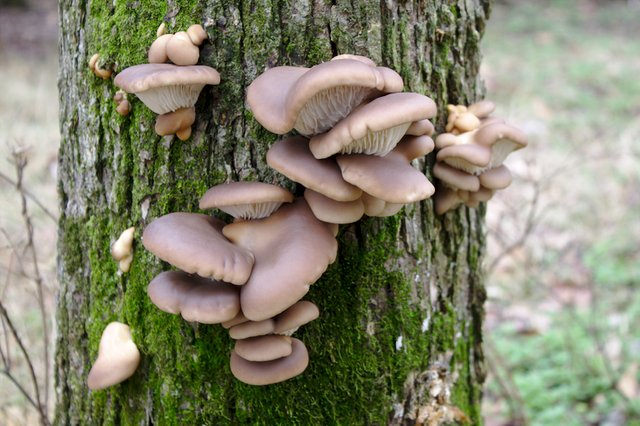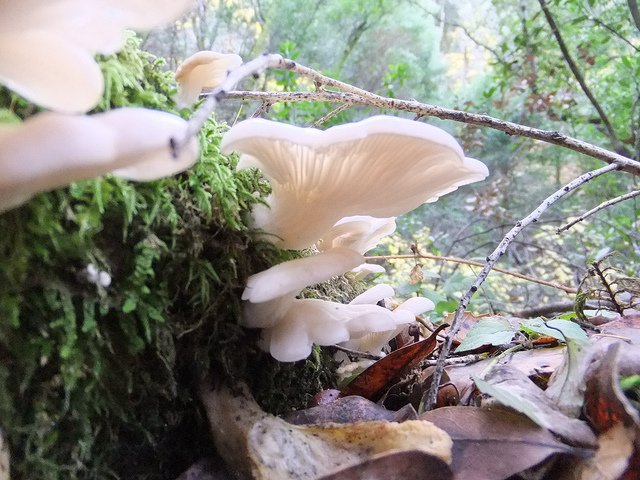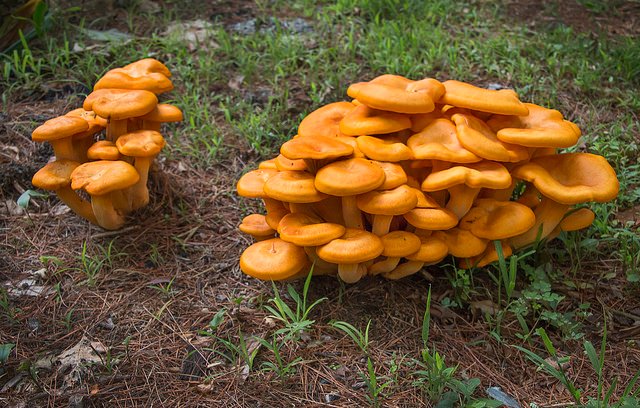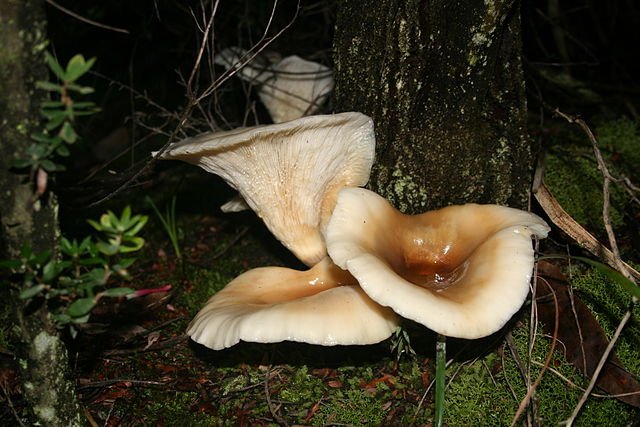All A Lot Of Oysters But No Pearls
I have to credit my son with this mycological find. My brother-in-law was down for Christmas, and he brought along his four wheeler, so I took my boy for a little ride around the pasture. When we drove through the small wooded patch in the corner, he commented, “I didn’t know mushrooms could grow on the sides of trees.” When I looked over, I saw an oak tree with a big patch of mushrooms growing out of its side.

Original Image
This was another specimen that I thought I recognized from pictures posted on an online forum. It is one of the more popular mushrooms in our area, because most folks consider it an edible… which brings me to my warning:
I am not an expert on fungi. I wouldn't even qualify as a hobbyist. I just enjoy taking pictures of natures tiny little details. Sometimes, curiosity gets the best of me, and I find myself trying to figure out exactly what it is that I was looking at. If I am correct on this one, then it would be edible, but I don’t even trust my own identification enough to eat them, so you DEFINITELY shouldn’t either. As such, this post is not intended for foraging purposes.
My guess: Pleurotus ostreatus - Oyster Mushrooms
I have seen quite a few pictures of oyster mushrooms posted online, and these bore a striking resemblance; however, I wasn’t sure what features I needed to look for to make a positive identification. So, I did a little bit of digging.P. ostreatus can be found throughout Asia, North America, and Europe. It is a saprobic fungus, meaning that it decomposes wood for use as an energy source. They may be found growing in shelf-like clusters on already-dead logs or on living trees; usually hardwoods like oak or beech. If you find specimen growing from a fallen log, you may find that they have a rather thick stem; however, when they grow from the side of a tree (like the ones I found), the stem tends to be very truncated and usually off-centered compared to the light brown colored cap, which can be anywhere from 5 to 25 centimeters across. The white to yellowish gills on the underside of the cap are decurrent, meaning that they extend down the length of the stem. A spore print will show up light gray to lilac in color on a dark background, and the mushrooms are said to smell like anise or black licorice. They are also often found to have a species of pleasing fungus beetle called Triplix horacica living on them.
My Specimen, In Comparison
The mushrooms that we found were growing out of the side of an oak tree. They tended to stack on top of each other in small clusters. Some of the larger fruiting bodies occurred at the base of the tree. They were about the size of my hand. The rest fit comfortably in my palm. When I pulled some from the side of the tree, they pulled away a small chunk of bark. Since this oak tree is still living, I hope the presence of these mushrooms doesn’t indicate that it is dying.
Original Image
Notice that the gills on the underside are white. With the way that these mushrooms were stacked on top of each other, I had a hard time finding a stipe; they were all very short. But when I did, I noticed that those gills ran most of the way down the stem.

Original Image
When I first tried smelling of the mushroom, I didn’t notice much. There was a slight earthy smell with a hint of something else that I couldn’t quite place. But, as luck would have it, I put my collection in a gallon sized ziplock bag to keep them while I did some research. By the time I opened the bag, again, the smell had concentrated enough that I could recognize it a little better. It was reminiscent of black licorice, but not exactly that. It is a smell that I can’t recall encountering before; not unpleasant, but not anything you would want your house smelling like.
I also found several bugs crawling around on the caps and in the gills of the fruiting bodies. There are several genera of beetles that feed on the fruiting bodies of mushrooms. Collectively, they are known as pleasing fungus beetles. The most common bug that I found on my collection had a black abdomen with a reddish orange colored head.

Original Image
After some research, I found this little bug to be some subgroup of the species Triplax thoracica. Interestingly, each species of pleasing fungus beetle is pretty specific to they type of mushroom that it will munch on, and species from the genus Triplax focus on oyster mushrooms.
The evidence was mounting in support of these being P. ostreatus, but there was one test left to perform: a spore print. I found a couple of fruiting bodies that would lay pretty flat when placed gill-side down and put them on a clear plastic tab divider. I had read that P. ostreatus spores should be light in color - light gray to lilac - so I put the tab divider on top of a dark background.

Original Image
It didn’t show up the lilac color that I had hoped to see, but it I think it is well within the range of possible colors that I read about.
Pleurotus Ostreatus Look-Alikes
In my research, I noted several P. ostreatus look-alikes including the angel wings mushroom, jack o lanterns, and ghost mushrooms, as well as several very closely related species that are more difficult to distinguish from ‘true oysters’.Angel Wings Mushroom

Image Credit: Angel Wings by Martin Jambon
Pleurocybella porrigens, commonly known as Sugihiratake in Japan or angel wings in the US has a tendency to grow out of the sides of trees and stumps, giving them a shelf-like appearance. However, to the knowledgeable and observant hunter, these should be pretty easy to distinguish from a tree oyster. For starters, angel wings generally grows on the wood of conifers, whereas P. ostreatus prefers hardwood, although it should be noted that it can be found growing on conifer wood on occasion. The fruiting body of P. porrigens is usually a creamy white color, while P. ostreatus is generally tan to brown. Furthermore, P. ostreatus is a much meatier mushroom than the angel wings
Angel wings were considered to be a safe edible mushroom for centuries, especially in Japan. However, during an exceptionally rainy fall in 2004, 59 people in Japan fell sick after eating them. 17 of those people died from acute encephalopathy. The poisonings were traced back to an amino acid called Pleurocybellaziridine that can be produced by the mushrooms. It is not known why that season’s angel wings crop was so deadly, but the average age of those who fell sick was 70, and only people with prior kidney problems died. One possible explanation is that people with compromised kidneys were not able to get rid of the toxin, so it built up to the point where it was able to get into the blood. Once there, it was carried to the brain where it began to cause fatal damage.
Omphalotus illudens

Image Credit:jack o lantern mushrooms by liz west
These mushrooms also can also grow from the sides of wood, giving them a shelf-like arrangement. They also have decurrent gills. However, that is about where the similarities to P. ostreatus end. Jack O’ Lanterns are decidedly orange on top with orange gills and an orange tinge to the flesh. It is also said that their gill will glow an eerie green color in the dark. O. illudens is toxic if ingested. It usually causes stomach cramps, diarrhea, and may affect the liver.
Omphalotus nidiformis

Image Credit: Omphalotus nidiformis on Leptospermum sp., Nannygoat Hill (Earlwood) NSW by Casliber; Attribution-ShareAlike 3.0 Unported (CC BY-SA 3.0)
Now, this one is a pretty good oyster look alike! Lucky for me, it doesn’t occur in the US; however, if you’re out hunting oyster mushrooms in Australia or Japan, keep an ey out for it. Omphalotus nidiformis, commonly known as the ghost fungus due to the fact that it glows in the dark, is a toxic oyster doppelganger said to cause severe vomiting within 30 minutes to 2 hours after ingestion. It is not usually deadly, and there shouldn’t be any lasting ill effects.
Other Oysters
There are other similar species within the genus Pleurotus that may be mistaken for the ‘true’ oyster, P. ostreatus; however, they are all edible. Most of them can be distinguished based on their color, the region where they are found, or the type of tree they are found on. The only other species in my area that I could have mistaken my collection for would be P. pulmonarius or P. populinis. True oysters are usually a darker brown than either of those two species. P. populinis usually grows on aspen trees. Since I found my collection on the side of an oak tree, I’m pretty sure it isn’t this species. P. pulmonarius is a little more difficult to rule out. It is named for the lung-like shape that its caps take on; however, P. ostreatus can look very similar. The key difference is that P. pulmonarius is usually found during spring and summer, whereas P. ostreatus is found more throughout fall and sometimes even winter time.Possible Medicinal Benefits
Oyster mushrooms are said to have several medicinal qualities; some of which are even back up by research. For example, a 1991 study in Annals of Nutrition & Metabolism (Institute of Human Nutrition Research, Faculty of Biotechnologies, Bratislava, CSFR) showed a 40% decrease in blood cholesterol in rats with hereditary sensitivities to alimentary cholesterol when P. ostreatus was included in their diet compared to the control group. Another study in the International Journal of Medicinal Mushrooms showed that extracts taken from P. ostreatus seem to exhibit anti-fungal and antibacterial properties, inhibiting the growth of several species, including S. aureus and E. coli. Interestingly, oyster mushrooms are also known to kill nematodes by releasing a toxin that immobilizes. Then, hyphae from the fungus will enter the nematode through a body orifice and begin to digest and consume it.In Conclusion
I am quite certain that my collection is Pleurotus ostreatus, the oyster mushroom; however, I am not sure enough that I am willing to consume them, even though there really aren't any dangerous look-alikes in my area. Apparently, they are pretty tasty, and I did find possible medicinal benefits to eating them, but I am leery about eating wild mushrooms. Perhaps, I will look into buying some to grow in my house, instead.
We grow them here but I would love to see them in the wild
Posted using Partiko Android
Awesome! I would like to try to cultivate these and start growing them indoors. You should (if you haven't, already) make a post showing how you grow them. I would be super interested to read that!
Will do that soon
Posted using Partiko Android
very interesting your publication. well-deserved the time spend reading this post.
You have a lot of knowledge about mushrooms.
Thanks! I used Google extensively to find most of that; but, now I'll know what I'm looking at the next time I find some!
Hi sustainablyyours,
Visit curiesteem.com or join the Curie Discord community to learn more.
Hi @sustainablyyours!
Your post was upvoted by Utopian.io in cooperation with @steemstem - supporting knowledge, innovation and technological advancement on the Steem Blockchain.
Contribute to Open Source with utopian.io
Learn how to contribute on our website and join the new open source economy.
Want to chat? Join the Utopian Community on Discord https://discord.gg/h52nFrV
Great post. Very informative. In my hometown people had a saying "to say I know is not to know, trying is how you get to know!" So, i'd give those mushrooms a try (little by little) :)
I may have a purgative at hand, just in case.
I grew up in a town with lots of vegetation and some of those speacies of mushrooms we had and some other varieties. Ironically people in venezuela do not use mushrooms as a main ingredient in any dish. It's a rather odd thing. I learned to eat them in the states while I was a grad student and i found them very tasty.
Thanks for sharing so much information and such great pictures.
Thank you! By the time I was confident in knowing they were safe, I was afraid that I had let them sit for too long. I am, however, going to try and cultivate them for indoor growth. We'll see how that turns out.
I see. Let's hope it workd. Looking forward to a follo-up on that.
I haven't known of mushrooms growing on trees to be edible. In the hometown where I was born, we used to hunt for mushrooms at the start of rainy season. My mother oriented me of only two types of mushrooms that are edible and both of those grow from the ground. However, the one on the first photo looks like the edible ones that I was told. Though, to your point, it may not be worth risking with it.
Your photos are great though. The jack-o-lantern mushroom looks cute and very colorful. 😊
I think these can be commonly found on dead limbs that have fallen to the ground. I'm afraid that their appearance on my tree may point to it being diseased, as they generally grow on dead or dying wood.
I wonder what dead limbs have for mushrooms to love growing on them. I too saw mushrooms growing on decaying woods, just not the same as those on your photo.
Very nice collections of pictures, and I am also happy to read from you again. This was a long time. I should get used to carry some zip-lock bags with me when I walk around with the boys, just in case we find something interesting to analyze later on (as you did).
Thank you! I got a little busy for a while, there. But, with STEEM prices so low, I figured it would be a good time to get it while it's cheap!
About keeping the mushrooms in ziplock bags: I found that leaving them for more than a day or so in a sealed bag caused mine to get kind of gross.
I was thinking about the ziplock bag for timescales of a few hours, not more :)
¡Hola! Lindas fotos, gracias por la información, de todas maneras hay que tener mucho cuidado con los hongos, el que no es un gran conocedor se confunde fácilmente con los tóxicos, te felicito por el voto curie, ¡Cuéntame! ¿Cómo te sentiste? un abrazo @sustainablyyours
¡Gracias! No tengo la suficiente confianza en mi capacidad de reconocer los hongos para comer lo que encuentro todavía. Estoy pensando en comprar uno de esos kits de cultivo donde puedo cultivar algunos hongos que sé que son comestibles.
PD. Espero que esta traducción tenga sentido. Utilicé el traductor de google.
¡Gracias por responder! Se entiende perfectamente, también uso traductor Google, cariños y besos.